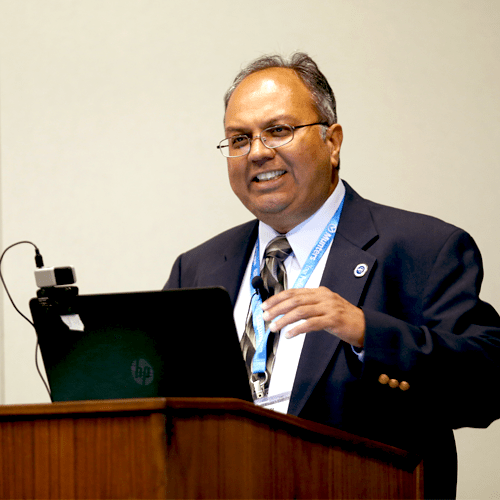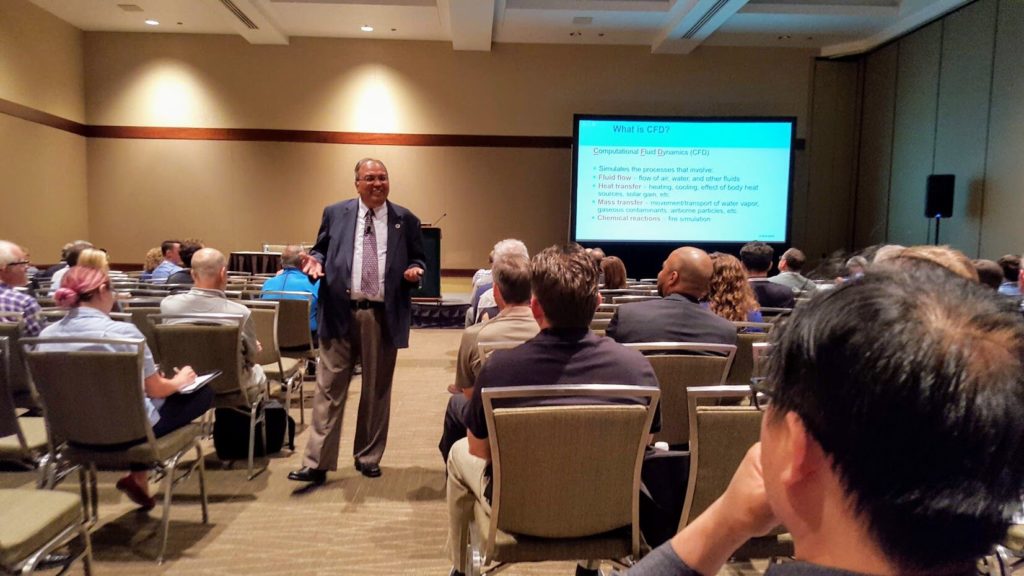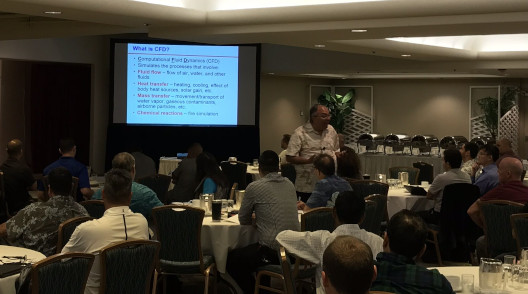Presentations
Presentation Video Gallery
ASHRAE Distinguished Lectures
Analysis of Airflow Patterns and Flow Path of Airborne Contaminants
Application of Computational Fluid Dynamics (CFD) for Built Environment (AIA and GBCI approved)
Airflow Management for Cleanroom Facilities (AIA and GBCI approved)
Airflow Management for Healthcare Facilities (AIA and GBCI approved)
Airflow Management for Laboratory Facilities (AIA and GBCI approved)
Stratified Air Ventilation Systems (AIA and GBCI approved)
Airflow Management Best Practices for Data Centers (AIA and GBCI approved)
Design and Analysis of Natural Ventilation Systems (AIA and GBCI approved)
Basics of Air Change Rates (ACH): Facts versus Fiction (AIA and GBCI approved)
Compassion in HVAC Designs
Other Lectures
Basics of Computational Fluid Dynamics (CFD) – Half Day Training
ASHRAE Learning Institute: FREE Webinar
Analysis of Airflow Patterns and Flow Path of Airborne Contaminants
Recent COVID-19 pandemic necessitates an increased need for understanding the room airflow patterns and its role in containing and spreading of airborne contaminants. With air being the primary carrier of heat, moisture, and airborne contaminants the flow path of supply air plays an important role in determining the flow path of airborne contaminants in indoor facilities. This course covers the basics of airflow and particle dynamics and demonstrates how the supply air flow paths, induced air flow paths, and exhaust grille placement can work collaboratively to establish protective and effective contaminant control in a typical patient room. Several studies indicate that the design of a ventilation system and the resulting airflow patterns play a more important role in controlling the flow path of airborne contaminants than just the supply airflow rate or air changes per hour (ACH) alone. This case study evaluates the impact of supply and return locations on the airflow patterns and temperature distribution along with the resulting thermal comfort of occupants. Probable flow path of airborne particulates in a typical patient room using Computational Fluid Dynamics (CFD) simulations are demonstrated. Insightful airflow animations will show the movement of airborne particles for various applications displaying the importance of HVAC design including the locations of supply and exhaust grilles. The course provides valuable insights to HVAC design engineers, facility managers, infection prevention personnel, and building owners regarding the role of airflow patterns and resulting flow path of airborne contaminants.
Keynote Address at Roberts Gordon Sales Meeting
FREE Master Class by TIPS: The Infection Prevention Strategy
Airflow Patterns and Flow Path of Airborne Particulates
This FREE Master Class is brought to you by TIPS: The Infection Prevention Strategy
Hospital-acquired infections has been persistent in hospitals and airborne transmission plays a role in many nosocomial infections. The flow path of supply air plays an important role in determining the flow path of airborne pathogens in these spaces. The airflow distribution also determines the thermal comfort of occupants, indoor air quality, distribution of surface contamination, and potential for transmission of airborne pathogens in a room. Several studies indicate that the design of a ventilation system and the resulting airflow patterns play a more important role in controlling the flow path of contaminants than just the supply airflow rate or air changes per hour (ACH) alone. This case study evaluates the impact of supply and return locations on the airflow patterns and temperature distribution along with the resulting thermal comfort of occupants, and probable flow path of airborne pathogens in a typical patient room using Computational Fluid Dynamics (CFD) simulations. This study demonstrates that the supply air flow paths, induced air flow paths, and exhaust grille placement can work collaboratively to establish protective and effective contaminant control. The presentation with the help of insightful airflow animations will show the movement of airborne particles in a patient room and will demonstrate the important of locations supply and exhaust grills. This presentation will provide valuable insights to healthcare facilities managers, owners and design engineers in designing the HVAC systems for patient rooms.
I2SL Webinar: Air Change Rate (ACR) or HVAC Configuration—Which Makes Labs Safe?
Often high airflow rates or air change rates per hour (ACH) for laboratory spaces are presumed to cover the risk of chemical exposure. Previous analysis indicated that high ACH does not necessarily create diluted indoor environment at all the time for all the occupants. This presentation with the help of Computational Fluid Dynamics (CFD) analysis will demonstrate the effect of HVAC configuration on the ventilation effectiveness of HVAC system. This study investigates the impact of number and location of exhaust grilles on the flow path of contaminants and the resulting transient and spatial distribution of contaminant concentrations in a typical lab. The ventilation effectiveness of the HVAC system is analyzed with the help of two non-dimensional indices. The analysis results are presented with insightful animations showing the progression and movement of contaminant cloud in the space.
I2SL Webinar: Do High Air Change Rates Make Labs Safe?
This study investigates the impact of ACH on the flow path of contaminants and the resulting transient and spatial distribution of contaminant concentrations in a typical lab. A total of four ACH levels varying from 4 to 10 are analyzed for the same generation rate of the contaminant and for the same layout of the ventilation system. Time varying concentration levels are predicted at the face level of three occupants located at three different locations in the lab as well as in the exhaust duct. Based on these concentrations the time varying chemical exposure (dose) for each occupant is calculated. This analysis shows depending on the position of the occupant relative to the source of contaminant and the location of exhaust grills the exposure levels can vary. High ACH does not necessarily create diluted indoor environment at all the time for all the occupants. The analysis results are presented with insightful animations showing the progression and movement of contaminant cloud in the space.
I2SL Webinar: Applications of Computational Fluid Dynamics for HVAC Design Optimization
Air is the primary carrier of heat, moisture, and contaminants in laboratory spaces. Therefore, proper airflow management is the key for effective laboratory ventilation. The design risk that can cause poor airflow management in laboratory spaces is often realized after commissioning and occupancy. However, computational fluid dynamics (CFD) can help identify risks during the early stages of designing a laboratory and help optimize an effective, energy-efficient HVAC system. This presentation will explain CFD technology and how to use it. It will also examine several case studies of laboratories, clean rooms, data centers, patient rooms, operating rooms, and office spaces to demonstrate how CFD analyses helped identify the risks and optimize the HVAC designs.





What lecture attendees say…
“Very practical and informative, beneficial for my job, Good talk with relevant examples” , “Very experienced presenter with good sense of humor. I have Better understanding of the topic after attending the lecture”
Kuala Lumpur, Malaysia ASHRAE Chapter
“Great sense of humor and enthusiasm”, “Great presenter, very engaging”, “Highly recommended speaker”
Tucson, Arizona ASHRAE Chapter
“All HVAC engineers need to see this presentation to better understand Physics of airlow”, “Dr. Khankari was very entertaining, stated importance of the topic and demonstrated examples throughout the industry. He was great with the audience.”, “Best Speaker. Great and organized presentation. Good depth and information.”
Tampa, Florida ASHRAE Chapter
“I am a non-technical person but Dr. Khankari presented a very technical topic in an easy to understand way.”, “Very dynamic speaker – fun to listen to – made a complicated topic very understandable.”
Detroit, Michigan ASHRAE Chapter
Request a lecture by Dr. Khankari
Lectures on applications of CFD for building HVAC, thermal comfort, and indoor air quality.
